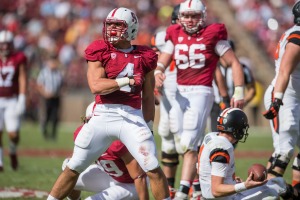The Stanford offense has been frustratingly hard to figure out through the first half of the season. First, it disappeared in South Bend before reappearing at home against Washington State to give fans hope. It then promptly vanished into the desert air in a demoralizing loss at Arizona State.
Don’t look now, but it’s back again.
The offense looked crisper and more effective than it had all season and the defense played its customary shutdown game as the Cardinal (5-3, 3-2 Pac-12) dismantled Oregon State (4-3, 1-3) in a 38-14 show for all of the alumni returning to the Farm for homecoming weekend.
“Washington State was close, but for the first time offensively, it felt like us,” said head coach David Shaw. “It felt like what we wanted to have. We ran the ball well; we pass protected. [Senior quarterback Kevin] Hogan threw the ball well.”

While Shaw said that it “felt like us,” however, it was clear right from the get-go that “us” referred to the Stanford of now and not the Stanford of the past. Shaw had noted in weeks past that he needed to do better at taking advantage of the kind of talent that he had on the roster, and it showed in the play-calling against the Beavers.
In a twist, the Cardinal took the opening kickoff and immediately came out in a no-huddle scheme, letting senior quarterback Kevin Hogan dictate the plays in a faster tempo. And in a quick, 8-play, 75-yard drive, Stanford drove down the length of the field and immediately put a touchdown on the board, looking nothing like the unit that couldn’t get a rhythm going in Tempe last week.
“It’s just something that we’ve been comfortable in, something that works for us,” Hogan said. “Hopefully it becomes more of the norm, because right now it’s where we execute offensively at our best. We’re able to do our things and execute against good looks on defense and it allows for more variety.”
In addition to the no-huddle, Stanford also showed a much greater willingness to attack the perimeter with simplified plays, including many shorter back-shoulder throws to receivers that put the playmaking onus not on Hogan’s arm, but on the receivers themselves to make defenders miss after the catch.
And make defenders miss they did. On that first touchdown, Hogan just found freshman running back Christian McCaffrey, who saw the most action of his career, about 10 yards downfield on a wheel route before the freshman unleashed a wicked spin that left two Oregon State defenders in the dust as he dashed for the 42-yard touchdown.
Then, to open the second quarter, 29-year-old senior wide receiver Jordan Pratt also picked up his first career touchdown on another simple 10-yard pass to the outside, after which he made a cut and took an angle that made almost every Oregon State defensive back miss as he ran diagonally to the end zone.
“We recognized that something needed to change and I think it changed for the better,” Hogan said. “We got back to the basics and just running the plays that we know and we can execute versus any look on defense. It allows us to play fast.
“I think it’s good to recognize that this team’s different, personnel-wise,” he added. “You’ve got to adapt to your personnel.”
Although the offense still wasn’t utilizing the zone read with Hogan as often, the one time it was called proved decisive, as Hogan pulled the ball and bounced outside for a huge 37-yard touchdown run highlighted by a ferocious stiff arm that pushed away a defender at the 5-yard line.
Hogan would finish the day 18-of-28 for 277 yards, two passing touchdowns, one rushing touchdown and two interceptions in a bounceback performance in which he always seemed confident and comfortable after the two early picks. In another promising development, five of Stanford’s eight first-half drives spanned at least 50 yards, with Stanford scoring touchdown on four of them to lead 28-7 at the half.
Meanwhile, the Stanford defense continued to eat opponents alive, allowing just 221 yards to the Beavers’ normally stout offense and experienced quarterback Sean Mannion. Mannion, who should become the conference’s all-time passing leader by the end of the season, was held to a paltry 122 yards passing on 14-of-30 completions by a ferocious Stanford pass rush and a stingy secondary that reduced Mannion’s margin of error to effectively zero.

Leading the charge was a retooled defensive line, which suffered from severe attrition when both junior Aziz Shittu and fifth-year senior David Parry went down, leaving freshman Harrison Phillips to start at nose tackle after struggling in the position last week. Due to those injuries as well, senior Alex Yazdi and junior Nate Lohn also saw meaningful action on the line.
But it didn’t matter who was plugging the gap at nose; the creative pressures from Henry Anderson and Blake Lueders, with significant help from inside linebacker Blake Martinez, got to Mannion more often than not, and Mannion found himself sacked six times throughout the afternoon. But even more of that help came from the lockdown play of the defensive backs.
“I think our defensive backs played well and forced the quarterback to hold the ball because a lot of those sacks weren’t within two seconds,” Shaw said. “Some were within four or four and a half seconds. So we had to make him get off his first read and go to the second read, and that’s coverage.”
With no openings to throw into and Stanford’s relentless pressure bearing down on him, Mannion was forced out of the pocket, which brought him out of his comfort zone and killed his accuracy on his throws.
The numerous NFL scouts in attendance to watch Mannion and the other talented players on the Oregon State and Stanford rosters instead saw plenty of Oregon State’s punter, who unleashed nine punts on the afternoon.
And Stanford’s special teams unit, which suffered from two fumbles last week that led to two Arizona State scoring drives, got its redemption when Ty Montgomery took a punt back 50 yards for an incredibly patient return touchdown, just following his blockers and not trying to get ahead of himself.
With Oregon looming on the horizon, this blowout was exactly what Stanford needed to regain its confidence, momentum and mojo before the toughest trip of its season up to Eugene to face the Ducks. Whether it will be enough — and whether the offense will finally be able to halt its ping-pong act — only time will tell.
“This is one of the most talented teams I’ve been on,” Hogan said. “I feel like when we put it all together and we just execute and don’t shoot ourselves in the foot, we can beat anyone. It’s going to be a lot of fun moving forward and just playing some football.”
Contact Do-Hyoung Park at dpark027 ‘at’ stanford.edu.
